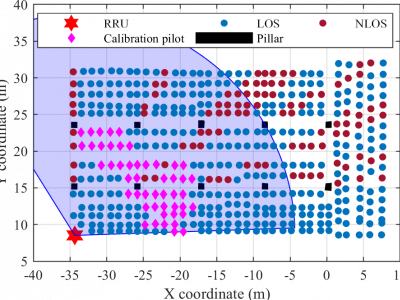5G

The data set contain network survey statistics from the county of Nottinghamshire for four major UK mobile operators. The data are collected from September 2022 till December 2022 and contain both 4G-LTE and 5G-NSA network information and their corresponding GPS location.
- Categories:
 70 Views
70 ViewsChannel frequency response (CFR) dataset used for "In-Situ Calibration of Antenna Arrays for Positioning With 5G Networks" paper (IEEE Transactions on Microwave Theory and Techniques, in print, doi: 10.1109/TMTT.2023.3256532, preprint link: https://arxiv.org/abs/2303.04470).
- Categories:
 2054 Views
2054 Views
Fifth Generation 5G cellular network users are increasing exponentially, where 5G coverage is a challenge for global telecommunications to provide end-users with maximum Quality of Experience (QoE). 5G technology New Radio (NR) is developed to address high bandwidth, low latency and massive connectivity requirements of enhanced Mobile Broadband (eMBB) compared to Fourth Generation (4G) Long-Term Evolution (LTE).
- Categories:
 1127 Views
1127 Views
This dataset includes real-world time-series statistics from network traffic on real commercial LTE networks in Greece. The purpose of this dataset is to capture the QoS/QoE of three COTS UEs interacting with three edge applications. Specifically, the following features are included: Throughput and Jitter for each UE-Application and Channel Quality Indicator (CQI) for each UE. The interactions were generated from a realistic network behavior in an office by developing multiple network traffic scenarios.
- Categories:
 2679 Views
2679 ViewsThe dataset was collected by performing uplink/downlink throughput measurements in Munich, Germany. The user side device was a vehicle with roof-mounted antenna (approx. 1.5 m height), and on the network side was a base station antenna mounted at the top of a building (height of the antenna with respect to the ground: 21 m). The measurements were collected at the center frequency of 3.41 GHz, with 40 MHz of bandwidth, with antenna gain of 15.5dBi (5dBi) at the base station (vehicle) side. The maximum throughput in the uplink was 40 Mbps.
- Categories:
 558 Views
558 Views
This dataset includes real-world Channel Quality Indicator (CQI) values from UEs connected to real commercial LTE networks in Greece. Channel Quality Indicator (CQI) is a metric posted by the UEs to the base station (BS). It is linked with the allocation of the UE’s modulation and coding schemes and ranges from 0 to 15 in values. This is from no to 64 QAM modulation, from zero to 0.93 code rate, from zero to 5.6 bits per symbol, from less than 1.25 to 20.31 SINR (dB) and from zero to 3840 Transport Block Size bits.
- Categories:
 1552 Views
1552 Views5G-NR is beginning to be widely deployed in the mmWave frequencies in urban areas in the US and around the world. Due to the directional nature of mmWave signal propagation, improving performance of such deployments heavily relies on beam management and deployment configurations.
- Categories:
 725 Views
725 ViewsThis data provides realized gain values for a handset operating at 28 GHz, with 3 4x1 linear antenna arrays placed around the handset along the right edge, bottom edge and back face of the handset. Beam steering was carried out at each of these antenna arrays and results for the handset with and without the hand phantom are included to show the effect that the introduction of the hand phantom has on the realized gain of the handset.
- Categories:
 138 Views
138 Views
This file contains VLC RSSI data from the IoRL Measurement campaign.
The processing files included are developed by Ben Meunier from Brunel University London.
- Categories:
 299 Views
299 ViewsExtensive experimental measurement campaigns of more than 30,000 data points of end-to-end latency measurements for the following network architecture schemes is available:
- Unlicensed IoT (standalone LoRa)
- Cellular IoT (standalone LTE-M)
- Concatenated IoT (LoRa interfaced with LTE-M)
Download Data.zip to access all relevant files for the open data measurements.
Related Paper:
- Categories:
 2684 Views
2684 Views

